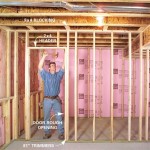Insulate My Basement Floor: A Guide to a Warmer, More Comfortable Home
A cold, damp basement floor can significantly impact the overall comfort and energy efficiency of your home. Insulating your basement floor is a worthwhile investment that can lead to a more pleasant living space, lower heating bills, and even mitigate potential moisture problems. This article will guide you through the process of insulating your basement floor, explaining the various methods and factors to consider.
Understanding the Benefits of Basement Floor Insulation
Insulating your basement floor offers a multitude of benefits, making it a wise choice for homeowners:
- Increased Comfort: A well-insulated basement floor creates a warmer and more comfortable environment, especially if you use the space for living purposes. This makes the basement more inviting for activities like entertaining, home offices, or playrooms.
- Energy Efficiency: By preventing heat loss through the floor, insulation helps to lower heating costs for the entire house. The warmer basement will also reduce the strain on your heating system, potentially extending its lifespan.
- Moisture Control: A properly insulated basement floor helps to control moisture levels by reducing condensation and preventing cold surfaces from attracting dampness. This is crucial for inhibiting mold growth and preserving the structural integrity of your basement.
- Enhanced Home Value: Investing in basement insulation can increase the overall value of your home. Potential buyers will appreciate the extra space and comfort it provides, potentially making your home more attractive in the real estate market.
Choosing the Right Insulation Method for Your Basement
The best insulation method for your basement floor depends on several factors, including existing conditions, budget, and desired level of insulation. Here are some popular options:
- Rigid Foam Board: This versatile material is easy to install and offers excellent insulation qualities. It comes in various thicknesses and can be used in conjunction with other insulation methods.
- Fiberglass Batts: Fiberglass batts are a cost-effective option for insulating between floor joists. They typically require a vapor barrier to prevent moisture damage.
- Spray Foam Insulation: Spray foam insulation is a popular choice for its excellent air sealing capabilities. It expands to fill gaps and cracks, providing a continuous insulation barrier.
- Loose-Fill Insulation: Loose-fill insulation, often made of cellulose or fiberglass, is blown into cavities and can be used in hard-to-reach areas like crawl spaces.
Essential Steps for Basement Floor Insulation
Once you've chosen an insulation method, proper installation is crucial for maximizing its effectiveness. Here's a general guide to follow:
- Prepare the Floor: Begin by thoroughly cleaning the basement floor and removing any debris. Make sure the floor is dry and free of moisture problems before starting the insulation process.
- Install a Vapor Barrier: A vapor barrier is essential for preventing moisture from migrating into the insulation. It should be placed over the floor before installing insulation.
- Install Insulation: The method for installing insulation will vary depending on the chosen material. Follow manufacturer instructions for proper installation.
- Seal Gaps and Cracks: Use a sealant or caulk to seal any gaps or cracks in the floor, preventing air drafts and maximizing insulation efficiency.
- Finish the Floor: Once the insulation is installed, you can finish the basement floor with various flooring materials like concrete, tile, or wood.
Insulating your basement floor is a worthwhile investment that can improve your home's comfort, energy efficiency, and overall value. By carefully selecting the right insulation method and following proper installation techniques, you can enjoy the benefits of a warmer, drier, and more comfortable basement for years to come.

Insulating And Finishing An Old Basement Floor Fine Homebuilding

Installing Rigid Foam Above A Concrete Slab Greenbuildingadvisor

What S The Best Way To Insulate A Basement Slab Greenbuildingadvisor

Cold Floors Over Basements How To Create A Warmer Floor Your Basement
How Would You Insulate Above A Concrete Floor Located Non Heated Garage When There Is 3 To Bring Up Grade Of The Adjacent Room Close In Porch

Should I Insulate My Basement Constellation

How To Insulate Your Existing Concrete Slab With Halo S Interra In 5 Easy Steps Buildwithhalo Com

What Is Basement Ceiling Insulation And It Worth

How To Properly Insulate A Concrete Floor Step By

Insulation Between Basement And First Floor Why It Matters For Your Home 1 800 Remodel
See Also








